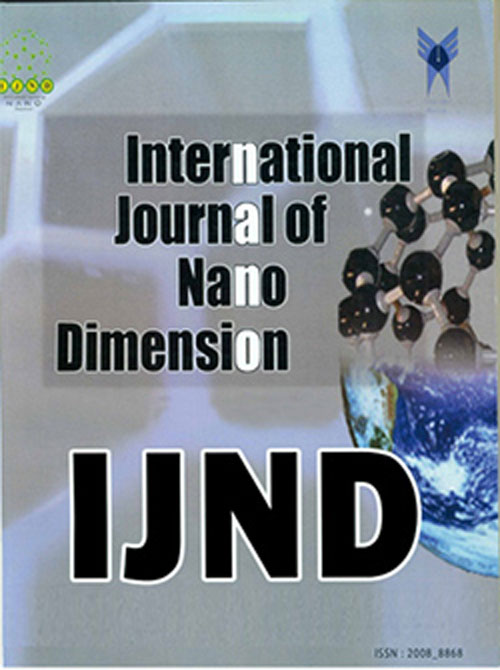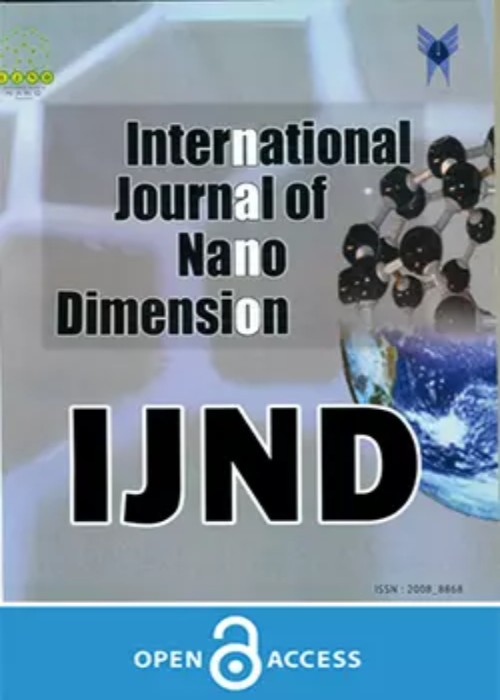فهرست مطالب

International Journal of Nano Dimension
Volume:13 Issue: 3, Summer 2022
- تاریخ انتشار: 1401/04/24
- تعداد عناوین: 8
-
-
Pages 256-266
Psychiatry involves the study of behavior, mind, personality, emotions, and human thoughts, which helps in the assessment and treatment of various mental health issues. Recently, the complexity of psychiatry has increased among all other medical specialties. Major depression is considered to become the global cause of disability by 2030. Antidepressants are the primary care or treatment given to any patient. Generally, antidepressants work by balancing the neurotransmitters in the brain, which accounts for the change in mood and emotions. The major problem limiting the use and research of antidepressants is blood brain barrier (BBB). They are highly selective for the movement of ions and molecules between blood and the brain. In particular circumstances, BBB hinders the entry of these drugs to the brain, thereby decreasing the efficacy, in turn increasing the side effects. Drug molecules larger than the pore size of BBB cannot pass through them. Nanopsychiatry deals with the application of nanoparticles in designing drugs, treatments, and diagnostic tools for several neurological and psychiatric illnesses. Nanoparticles exhibit a large surface-to-volume ratio which empowers them to remain a primary part of an effective drug delivery system. Nanocarriers made up of biodegradable polymers can overcome the limitations of BBB. Other than polymers, novel surfactant- based nanocarriers are a successful carrier of the drug across the BBB. This review discusses the severity of depression and the need for novel nanoassisted drug delivery systems.
Keywords: Anti-Depressants, Depression, Nanopsychiatry, psychiatry, psychotherapy -
Surface, structural and optical investigation on Poly Vinyl Alcohol (PVA)/Bi2WO6 nanocomposite filmsPages 267-281Bismuth tungstate (Bi2WO6) emerged as one of the most capable chromogenic compounds among transition metal oxide having wide opto-electronic applications. It is an n-type semiconducting material having bandgap around ~2.7eV. Conversely, NanoComposite (NC) materials have been investigated in order to tailor the properties polymers and also to widen the applications. In this context Poly (vinyl alcohol)/ Bismuth tungstate (PVA/Bi2WO3) NC films were prepared with various weight ratio of Bi2WO6 content viz.0, 0.1, 0.2 0.4, and 0.8 wt%. The solution combustion method was employed to prepare Bi2WO6 nanoparticles (NPs). Subsequently, synergistic effect of polymer matrix and Bi2WO6 NPs is characterized and analysed to estimate the enhanced properties. The surface morphology of the NC’s films was explored by Scanning Electron Microscopy (SEM). Elemental analysis is carried out using EDAX. The formation of polymer NC and its microstructural properties were investigated by X-ray diffraction technique and it is revealed that there is formation of orthorhombic phase for Bi2WO6 NPs with an average size of 35nm. Interaction of NP and PVA is studied using FT-IR spectrometer. The optical constants were evaluated by UV-visible spectrometer and it was found that NC films bandgap energy varied from 5.4 eV to 2.85eV for direct and from 4.57eV to 2.38eV for indirect bandgap. It is anticipated that these unique organic–inorganic NC materials are the emerging functional materials in the field of opto-electronics.Keywords: Bandgap, Bismuth Tungstate, nanocomposite, nanoparticles, PVA
-
Pages 282-295A novel, one-step, facile and low-cost strategy was successfully designed to synthesize iron hydroxyl phosphate (IP) nanosheets via solvothermal method using iron (II) sulfate heptahydrate, ethylene glycol, and phosphoric acid. Then, for the first time, the flame retardant and smoke suppressant properties of the IP were studied. The synthesized IP nanosheets were added into the polyacrylonitrile (PAN) matrix, by a solvent blending method, to prepare PAN/IP nanocomposite. The structure and morphology of the IP nanosheets were carefully characterized by X-ray diffraction (XRD), X-ray photoelectron spectrum (XPS), Fourier-transform infrared (FT-IR) spectroscopy, Raman spectroscopy, field emission scanning electron microscopy (FE-SEM) and transmission electron microscopy (TEM). In addition, the thermal stability, flame retardancy and fire hazard of the PAN/IP nanocomposite were investigated by thermogravimetric analysis (TGA), cone calorimetry, and UL-94 vertical burning test. The PAN/IP nanocomposite exhibited significantly higher smoke suppression and flame retardancy capability as well as less fire hazards than those of the pure PAN. Moreover, incorporation of the IP into the PAN matrix increased the residual char. These improvements were attributed to the ability of the IP to contribute in formation of effective barrier char layer on the PAN, sheet-like morphology of the IP as well as catalytic activity of the IP in carbon monoxide (CO) oxidation.Keywords: Char Barrier Layer, Fire Hazard, Flame Retardant, Iron Hydroxyl Phosphate Nanosheets, Polyacrylonitrile, Smoke Suppressant
-
Pages 296-310In the present work the flow boiling charecteristics of CuO/water nanofluid were studied experimentally and the statistical as well as regression analysis were conducted to asses the flow boiling heat transfer coefficient and the influencing parameters. For this, CuO/water nanofluid was prepared by two step procedure for the particle concentration of 0.001%, 0.005%, and 0.01 % respectively. The experiments were conducted by varying the heat flux and mass flux ranging from of 50-200 kW/m2 and 380-955 kg/s-m2, respectively for water and CuO/water nanofluids. All the experiments were conducted for the same temperature of water at heater inlet. A full factorial multi-level design approach was used to design the experiments by considering the heat flux, mass flux and particle concentration are key influence parameters. Results showed that the boiling heat transfer is increases with mass flux and heat flux for both water and nanofluids. Furthermore, increasing the nanoparticle concentration enhances the flow boiling heat transfer rate and lowers the wall temperature. It is observed that at a mass flux of 954.29 kg/s-m2, the maximum decrease in wall superheat is 18.66 % for 0.01% CuO/water nanofluid. From statistical analysis, it is noticed that the aforementioned factors were statistically significant. Furthermore, heat flux has a considerable influence on the boiling heat transfer coefficient, which is followed by mass flux and particle concentration. The heat transfer coefficient was predicted using a simplified quadratic model, which was found to be in good agreement with the experimental results.Keywords: CuO, water Nanofluid, Flow Boiling Curve, Heat Flux, Mass Flux, Heat Transfer Coefficient, Particle Concentrations
-
Pages 311-319
In this paper, the thermoelectric properties of zigzag single-walled carbon nanotubes (SWCNT) and zigzag single-walled boron nitride nanotubes (SWBNNT) are investigated. For this purpose, the chirality is considered as (9, 0). The characteristics are computed at three arbitrary temperatures of 200K, 300K, and 500K. Results show the Seebeck coefficient of zigzag SWCNT increases by increasing the temperature, while decreases for the zigzag SWBNNT. The peak of the Seebeck coefficient of the zigzag SWCNT at the temperatures of 200K, 300K, and 500K are , , and , respectively. The associated values of SWBNNT are, , and , respectively.Besides, it is observed that at the temperature of 200K, the Seebeck coefficient zigzag SWBNNT is about 88 times the value of zigzag SWCNT. Moreover, due to the Seebeck coefficient sign type in the Fermi energy range, both of the considered nanostructures are semiconductors and n-type. It is depicted that the electrical conductivity and total thermal conductance of SWCNT are larger than SWBNNT. Efficiency is an important parameter to characterize the thermoelectric properties of nanomaterials. Results show the figure-of-merit (ZT) value of SWBNNT is much better than that of SWCNT. Due to the contribution of phonons, the zigzag SWBNNT has larger Seebeck coefficient. The studies show that the maximum value of ZT of the zigzag SWBNNT at the temperatures of 200K, 300K and, 500K are larger than 0.0207, 0.0342 and, 0.0718, respectively. The results of this study can be useful in the design of nanoelectronic, and cooling systems.
Keywords: Atomistix ToolKit, density functional theory, Single-Walled Boron-Nitride Nanotubes, single-walled carbon nanotubes, thermoelectric properties -
Pages 320-328The aim of this study was to prepare, the physicochemical assessment and the cytotoxicity testing of cisplatin-loaded mesoporous silica nanoparticles against head and neck squamous cell carcinoma cell line (HNSCC). Cisplatin-loaded mesoporous silica nanoparticles were prepared through the precipitation method. The prepared nanoparticles were evaluated by conventional methods in terms of physicochemical properties. The cytotoxic effect of the nanoparticles and the free cisplatin were assessed on the head and neck squamous carcinoma cell line. The results showed that the prepared nanoparticles with nanometer size and the negative surface charge belonged to the MCM-41 silica family. TEM images established the mesoporous construction and the rod-shaped morphology of the produced nanoparticles. Based on Brunauer-Emmett-Teller (BET) analysis, the specific surface area, pore volume, and pore diameter decreased compared to free mesoporous silica because of drug filling into the mesoporous pores. The nanoparticles showed a two stage release pattern that continued slowly until the 35th day. Mesoporous silica nanoparticles displayed no significant cytotoxic effect on HNSCC. Cisplatin displayed a cytotoxic effect with IC50 of 82.01 μM and 33.67 μM in 24 h and 48 h incubation times, respectively. However, cisplatin-loaded mesoporous silica nanoparticles displayed a cytotoxic effect with IC50 of 26.17 μM and 13.28 μM in 24 and 48 h incubation times, respectively. The results can highlight the capability of cisplatin-loaded mesoporous silica nanoparticles to be applied in the treatment of oral cancerous cells.Keywords: Anticancer effect, Cisplatin, Head & Neck Squamous Cell, Cytotoxicity, Oral cancer, Silica nanoparticles
-
Pages 329-334In the current investigation phytochemically mediated, easy, efficient, and eco-friendly green synthesis of silver nanoparticles (AgNPs) was carried out using Entada rheedii leaf extract as a reducing and capping agent in a microwave-assisted synthetic pathway. UV-Visible spectroscopy, IR spectroscopy, scanning electron microscope (SEM), and transmission electron microscopic (TEM) techniques were used to confirm the formation of silver nanoparticles. The functional groups present in the capping agent were identified by FTIR analysis. SEM and TEM analysis studied the surface morphology of the biosynthesized AgNPs. AgNPs also showed significant antibacterial effects against four different bacterial pathogens Escherichia coli, Klebsiella pneumoniae, Staphylococcus aureus, and Vibrio cholera. Additionally, the prepared AgNPs exhibited solid anticancer activity against Dalton's lymphoma ascites (DLA) cells.Keywords: Anticancer Activity, Anti-microbial activity, Entada Rheedii, IR spectroscopy, SEM, TEM
-
Pages 335-343Synthesizing plant-derived nanoparticles attract attention due to both their broad-spectrum biological applications and sustainable production. This paper describes the production of Cobalt oxide nanoparticles (Co3O4 NPs) using M. charantia leaf extract. The Uv–Vis absorption spectrum of them has peaks at 309 and 595nm. FTIR spectroscopy reveals bands at 580cm-1 and 667cm-1 and confirms the formation of Co3O4. The particle size was determined by XRD to be between 44.68 and 89.20nm. The Field Emission Scanning Electron Microscopy (FESEM) showed that Co3O4 NPs were irregular in shape and between 40 and 90nm in size. Further, the dye degrading capacity of this nanoparticle was ascertained. The dye degrading capacity of Co3O4 NPs exhibited was 81.50% obtained at 90 minutes of light irradiation.Keywords: Dye Degradatio, FESEM, Green synthesis, Momordica charantia, Photocatalytic Activity, XRD


